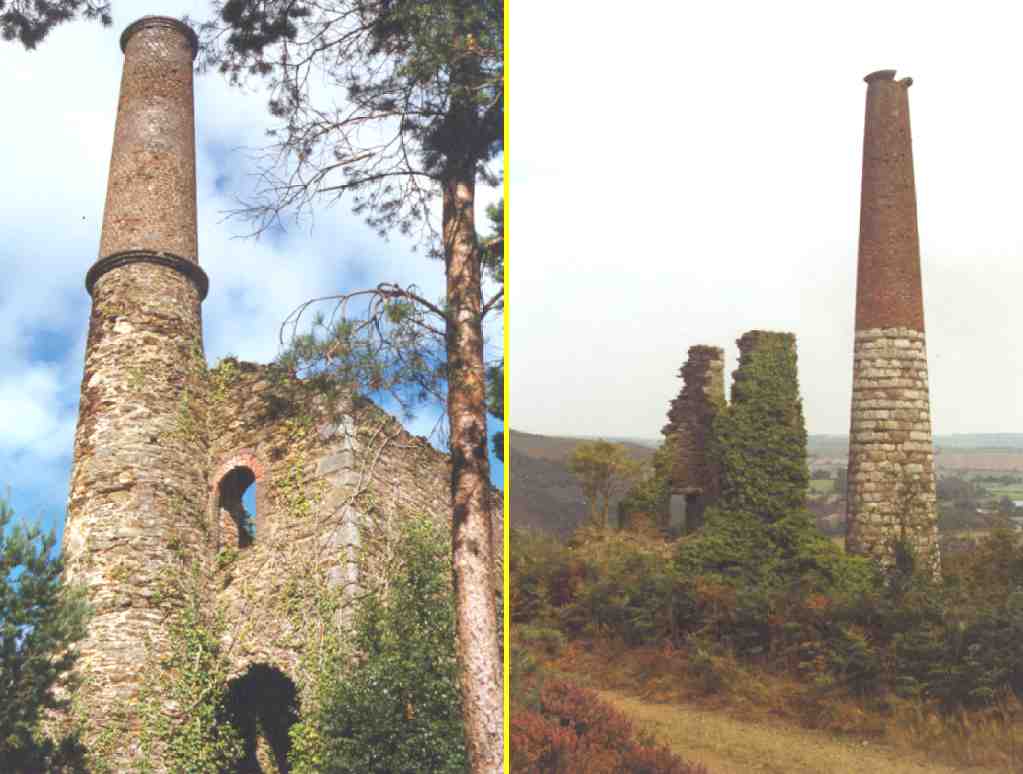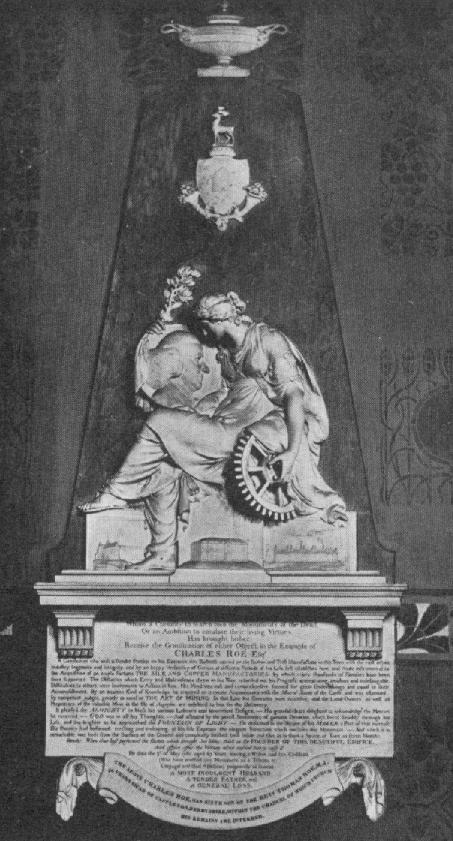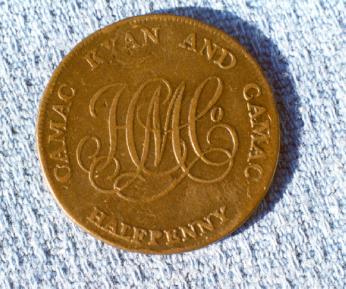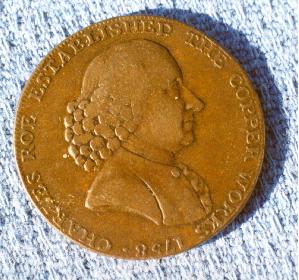
Some Anglo-Irish Copper Mining Tokens Of The Late Eighteenth Century.
The halfpenny token illustrated below was issued by the Associated Irish Mine Company for payment to their employees who were principally engaged in copper mining activities in the Vale Of Avoca in Southern Ireland.

Reverse of an A
ssociated Irish Mines Company Halfpenny token of 1789.Such commercial tokens were mass-produced during the late eighteenth century by many British companies at a time when there was a shortage in circulation levels of official coin of the realm.
At a time of rapid industrial growth in Britain’s economy it was important for concerns like the Associated Irish Mine Company (AIMC) to have a plentiful supply of "ready cash" to meet the demands of their growing business ventures. Despite calls from many quarters for the Royal Mint to produce new copper coin issues the British government was reluctant to act. As a result the captains of Britain’s Industrial Revolution were forced to enter into contracts with private mints (most of which were located in Birmingham) to produce the coinage that they so desperately needed.
The Associated Irish Mine Company (AIMC) was established c.1787 by Abraham Mills (who was later to become Company Chairman), William Roe, Thomas Weaver the elder, Thomas Smith, Charles Caldwell and Brabazon Noble. The company's principal concerns were in copper mining in the Wicklow Hills of Southern Ireland. The official offices of the company were located at 184, Great Britain Street, Dublin. In 1798 the company was incorporated by an Act of Parliament.
The AIMC’s premier mine was located at Cronebane, across the river from Ballymurtagh, about two miles north of the present village of Avoca (better known today by its TV pseudonym "Ballykissangel"). The company had a second mine half a mile south of Cronebane at Tigrony.

Two of the remaining mine engine houses in the Avoca region. RIGHT - Baronets Engine House (Cornish Style) in the Cronebane area of East Avoca. LEFT - The remains of Ballygahan Engine House in the Ballymurtagh area of West Avoca (Photographs courtesy of Nick Coy).
The Cronebane halfpennies carry the official Coat of Arms and Crest of the AIMC. It is likely that this same heraldic device was incorporated into the design of the Common seal of the Company, which they were empowered to use by Act of Parliament.
The tokens of the AIMC were extremely prolific and they, together with those issued of the Hibernian Mine Company (HMC), formed the basis of Ireland's currency during the late eighteenth and early nineteenth centuries. This shows how readily exchangeable and accepted such commercial tokens became. This is quite in contrast to the more limited mining "Truck" or "Tommy Shop" token issues which were also a feature of Britain’s Industrial Revolution.
There are at least thirty varieties of the Cronebane halfpenny recorded many of their differences being very trivial. A further twenty-four contemporary counterfeit type and twenty die mules are also known. Issue dates range from 1789 to 1796. A description of one of the commonest types of Cronebane token is given below;
OBVERSE DESIGN: Head and shoulders of St. Patrick portrayed as a Bishop facing right. A legend around reads; CRONEBANE HALF PENNY.
REVERSE DESIGN: A windlass (manually operated shaft winch) above a shield bearing the company's coat of arms displaying two spades, three picks and a horn of gun powder for blasting. A legend and date around reads; ASSOCIATED IRISH MINE COMPANY 1789
EDGE DESIGN: An incised legend reads; PAYABLE AT CRONEBANE LODGE OR IN DUBLIN
The above details given on the edge of the token are a reference to those places (i.e. the AIMC's head office in Dublin and at Cronebane Miners' Lodge) where the halfpenny tokens were exchangeable, in sufficient quantity, for official coin or notes of the realm.
It is known that the firm of Roe and Company, of Macclesfield in England, were intimately associated with the AIMC. In fact the latter was a sister concern to the Macclesfield based company which had various copper smelting works throughout England and Wales. Without doubt Roe & Co.'s works smelted most of the copper concentrates produced by the AIMC's mines.
The founder of Roe and Company (otherwise known as the Macclesfield Copper Company) was Charles Roe (1715-1781). Roe was a leading industrialist of the mid 1700's. Much of his wealth and business empire was based on his various mining and metallurgical interests although he was also a well know silk manufacturer and mill owner in his home county of Cheshire. There still exists a memorial tablet to him in Christ Church, Macclesfield, which carries a lengthy inscription to his various lifetime achievements in the silk and metal trades.

The memorial tablet to Charles Roe in Christ Church, Macclesfield.
Charles Roe was born in Castleton, Derbyshire but later moved to Macclesfield in Cheshire. By 1758 he had established himself as a major force in the silk trade which he had helped to establish in his adopted town. However, it was in this year that Roe is first known to have diversified his business interests into the fields of copper mining and smelting.
Simultaneously in 1758 Roe is recorded to be mining copper ore in the nearby ancient mines on Alderley Edge and from another mine site at Coniston, in the Lake District. In the same year Roe also built a copper works on Macclesfield Common to smelt the mineral concentrates from his new mining ventures. Presumably Roe’s choice of Macclesfield for the location of his new copper works was due to its close proximity to Alderley Edge and the initial availability of shallow lying coal seams just outside the town. Coal was an important requirement for fueling Roe’s new smelting houses. Shortly after the foundation of the Macclesfield copper works Roe set up others close by near Congleton and at Bosley.
By 1768 Roe had ceased mining at Alderley Edge. His mining operations at Coniston lasted for a further two years until 1770 when he finally abandoned them. As part of an interim measure, prior to acquiring a major new mining lease of his own, Roe turned to smelting copper ore from The Duke of Devonshire’s mines on Ecton Hill in Staffordshire. Zinc ore concentrates from North Wales were also smelted at the Macclesfield works and the resulting metal alloyed with copper to produce brass. In later years Roe’s various works were also to smelt copper concentrates originating from Cornish mines. This arrangement continued until at least 1799.
In 1763 Roe acquired a new mining lease on a prospect later to be known as the Mona Mine on Parys Mountain in Anglesey. After the discovery of a major copper load at the mine in1768 it became hugely profitable for Roe and his associates. Although the Macclesfield based company lost their mining lease on the Mona Mine in 1786 they led the way for others, such as the world famous Parys Mine Company, to develop the Anglesey deposits further in later years.
By 1767 Roe & Co. decided to move their smelting operations nearer to the source of their new ore supply. Transportation costs for carrying both ore and coal to Macclesfield were becoming too prohibitive especially following the exhaustion of the Macclesfield coal reserves some years earlier. The company opened the first of two successive smelters on the banks of the Mersey in Liverpool. They later obtained possession of a colliery at Wrexham so as to secure themselves a reliable and local source of fuel.
It was after the loss of their mining lease on Parys Mountain that Roe & Co. turned their attention to acquiring the copper mines north of Avoca in Ireland. In order to man their new Irish mines Roe & Co., now working through their newly formed subsidiary the AIMC, relocated many of the miners who had previously worked for them in their Mona Mine on Anglesey. By this time Charles Roe had died and the company he had founded was being run by Edward Hawkins, a merchant of Congleton, Abraham Mills, of Macclesfield and William Roe (Charles’ eldest son).
Roe & Co.’s newly purchased copper mines were those previously worked around Cronebane by the Hibernian Mining Company (HMC). By 1786 the HMC had moved the centre of their operations to Ballymurtagh on the western bank of the Avoca River, adjacent to Tigrony. The sale of the Cronebane Mines to Roe & Co. was, in retrospect, to prove a bad move for the HMC as rather than being "worked out" the Cronebane Mine continued to hide its best kept secret until 1788. In this year a six to eighteen feet wide lode of high grade copper ore was discovered. This rich vein was to prove extremely lucrative for the AIMC for many years. Intense rivalry between the Irish owned HMC and the English controlled Cronebane Mines was to become a dominant theme in their two close knit histories. No doubt the bad feelings between the two companies, and their ethnically different workforces, reached a peak during the civil unrest in Ireland which led up to the abortive Irish Rebellion of 1798. Prior to the rebellion both mining companies had raised their own private militia and fitted them out with uniforms and arms. However, the HMC’s owners and workforce were strongly suspected of having sympathies with the outlawed Republican group the "United Irishmen" and their allegiance to the crown was most definitely under question. In early 1798 the HMC were linked to an incident whereby a republican agent had been caught trying to infiltrate local groups of Orangemen. Subsequently the HMC disbanded both their infantry and cavalry corps. Months later the rebellion broke out and temporarily put a holt to mining in the Vale of Avoca.

Obverse of a halfpenny of the Hibernian Mine Company bearing the company’s cypher "HMCo. " . Around the edge a legend records the names of the company's chairman (Turner Camac), his brother (James Camac) and the company's founder (John Howard Kyan).
Like their Irish subsidiary Roe & Co. also issued halfpenny tokens of their own. The circulation of these was primarily aimed at the company’s work force in Liverpool, Macclesfield, Bosley and Congleton. However, like those of the AIMC the tokens of Roe &Co. were inevitably to have a much wider sphere of circulation. Several different token designs and die varieties were issued by the Macclesfield based firm. At least 11 tons of tokens were minted in the company’s name between 1789 and 1793. The example of Roe & Co.’s token issues that is most commonly encountered today is described below;
OBVERSE DESIGN: Right facing portrait of Charles Roe around which is the informative legend "CHARLES ROE ESTABLISHED THE COPPER WORKS 1758". This is a reference to the Macclesfield Copper Works.
REVERSE DESIGN: A seated female representing the Genius of Industry holding the shaft of a windlass in one hand and a cogwheel in the other. Behind is depicted a mine capstan . Around a legend reads MACCLESFIELD HALFPENNY.
EDGE DESIGN: An incised legend reads; PAYABLE AT MACCLESFIELD LIVERPOOL OR CONGLETON

Obverse of a Roe & Co. Halfpenny of 1789
The designs of both Roe & Co.’s and the AIMC’s tokens are attributed to John Gregory Hancock. Hancock was probably responsible for their minting also. However, the manufacture of many of them can be traced back to a separate contract placed with Matthew Boulton at his famous Soho Works in Birmingham. No doubt the copper used in the tokens manufacture originated from Roe & Co.’s various smelting and refining works.
During the later 1780’s and the 1790’s the organization of Roe & Co.’s business empire was to undergo several changes. The company entered into another copper mining venture at Llanberis in Wales and joined the band of copper firms that had already become established in the Greenfield Valley area of Flintshire. Here they established works for calcining and smelting both lead and zinc ore concentrates. The company also opened a new smelter at Neath Abbey near Swansea and took delivery of the first shipment of Irish ore to its new works in 1794. By this time South Wales was rapidly becoming the focus for copper smelting in Britain. The opening of the Neath works coincided with the closure of the company’s operations on Merseyside. The reasons given for the company’s move to South Wales were that both the cost of labour and coal were becoming too expensive in Liverpool. To ensure better control over the supply and price of coal for their Neath works Roe & Co. bought shares in one of the local colliery concerns.
The new smelting site at Neath treated concentrates from Cornwall and the company’s own mines in Ireland and Llanberis. However, the increasing level of duty the company had to pay on the import of its Irish ore was to become a point of concern. Roe & Co. finally decided to close their Macclesfield, Congleton and Bosley works in 1801. Their operations in Wales continued until 1811 when they sold most of their interests in the Neath Abbey works to the Cheadle Copper And Brass Company. The company’s subsidiary mines in Ireland, under the management of the AIMC, continued to operate, under ever worsening mining and market conditions, until 1808 when operations were finally wound down. The AIMC’s rival Irish operation, the HMC, working over the River Avoca did not fair quite so well. Despite investing heavily in their Ballymurtagh Mines they ceased production on the site in 1800.
References & Acknowledgements:
Meetings and private communications with Nick Coy. 1997 to 1998.
Wicklow - History & Society. Chapter 19. Edited by Ken Hanningan & William Nolan. Geography Publications. 1994. ISBN 0906602300.
Avoca - Our Heritage. Alan Thomas & Peadar McArdle. Geological Survey of Ireland. 1998. ISBN 1 899702 16 4.
A History of Macclesfield. Part III- Manufacturers. Edited by C. Stella Davies. Publishers E.J. Morgan. ISBN 0 85972 034 9.
Charles Roe of Macclesfield - An Eighteenth Century Industrialist (Part II). By W.H. Chaloner. Transactions of the Lancashire & Cheshire Antiquarian Society. Vol. LXIII. Pages 52 to 86. 1952/53.
The Copper King - A Biography of Thomas Williams of Llanidan. By J.R. Harris. Liverpool University Press. 1964.
Commercial Coins 1787 - 1804. by R. Bell. 1963.
Druid Tokens - Eighteenth Century Token Notes From Matthew Boulton's Letters. The Anglesey Series. By C.R. Hawker. Brewin Books. 1996. ISBN 1 85858 082 X.
The Provincial Token-Coinage of the Eighteenth Century. By R. Dalton & S.H. Hammer. Allan Davisson. 1996 Edition. ISBN 0 9627694 0 9.
Based on an article in NMMA Newsletter No.12, September 1998. © Mark Smith.